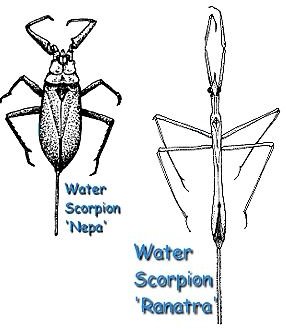Water Scorpion Facts: Learn About these Amazing Water Bugs
The Water Scorpion

Water scorpions are not true scorpions (a type of arachnid). They are an aquatic insect within the order Hemiptera or “bugs”. They somewhat resemble a scorpion but have wings and only three pairs of legs instead of four. They were given this name because of their specialized grasping forelimbs. Below are more interesting water scorpion facts.
Description
Two genera are widely distributed in North America. Nepa water scorpions are about 0.6 to 0.8 inches long with a 0.3 to 0.4 inch ’tail’. Their bodies are flat and dark brown in color. Adults are fully winged but do not fly. Ranatra water scorpions are longer and much slender than the Nepa. They are about 1.2 to 1.4 inches long with a 0.4 to 0.6 inch ’tail’ and are pale buff in color. Adults have wings and can fly on warm days.
Habitat
Although water scorpions live in the water, they are air-breathers and poor swimmers. They prefer still waters in shallow lakes and ponds but can also be found living in brackish dykes and streams. They mostly cling to twigs and weeds close to the surface, head down. Their ’tail’ is used as a siphon to obtain air from the water surface, similar to a snorkel. When they do move, they move very slowly. They can swim short distances and crawl along the bottom of the water. They can go without air for up to 30 minutes.
Diet
Water scorpions are ambush predators. When prey approaches, they will lunge forward and grab it with their powerful forelimbs. Then, they pierce the victim’s body with their rostrum (tube-like mouth-part) and suck out its insides. Prey include small insect larvae, water fleas, water lice, and water worms.
Reproduction
Mating normally takes place in the spring. The males attract the females with a quiet chirping sound. Shortly after mating, the females will lay their eggs at night just below the surface of the water on water plants. She lays about 30 eggs in one night. The eggs have anterior horns (spiracles) that penetrate the water’s surface. This provides oxygen to the eggs. In 3 to 4 weeks, the eggs hatch. Water scorpions undergo a type of development known as incomplete metamorphosis. The young go through a series of molts, their appearance is similar to the adult, and there is no pupal stage. It takes about 6 to 8 weeks for larvae to develop into adults.
More Information
The following are more interesting water scorpion facts:
• To keep from straying into deeper waters, they have pressure sensors on the underside of their abdomen that inform them of the depth.
• Nepa water scorpions resemble a brown leaf. This camouflage helps protect them from predators and it helps them catch their prey.
• Predators include ducks, fish, large insect larvae, and leeches.
References
https://www3.northern.edu/natsource/INVERT1/Waters1.htm
https://www.naturegrid.org.uk/biodiversity/invert/watscorp.html
Photo Credit
Image courtesy of https://dnr.wi.gov/org/caer/ce/eek/critter/watercritter/scorpion.htm